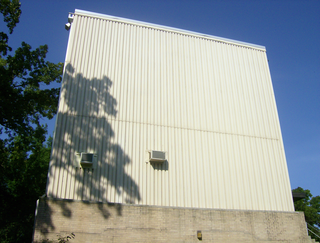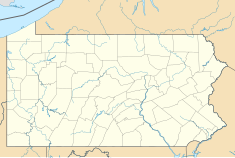
A nuclear reactor is a device used to initiate and control a fission nuclear chain reaction or nuclear fusion reactions. Nuclear reactors are used at nuclear power plants for electricity generation and in nuclear marine propulsion. Heat from nuclear fission is passed to a working fluid, which in turn runs through steam turbines. These either drive a ship's propellers or turn electrical generators' shafts. Nuclear generated steam in principle can be used for industrial process heat or for district heating. Some reactors are used to produce isotopes for medical and industrial use, or for production of weapons-grade plutonium. As of 2022, the International Atomic Energy Agency reports there are 422 nuclear power reactors and 223 nuclear research reactors in operation around the world.

The High Flux Australian Reactor (HIFAR) was Australia's first nuclear reactor. It was built at the Australian Atomic Energy Commission Research Establishment at Lucas Heights, Sydney. The reactor was in operation between 1958 and 2007, when it was superseded by the Open-pool Australian lightwater reactor, also in Lucas Heights.

The Bhabha Atomic Research Centre (BARC) is India's premier nuclear research facility, headquartered in Trombay, Mumbai, Maharashtra, India. It was founded by Homi Jehangir Bhabha as the Atomic Energy Establishment, Trombay (AEET) in January 1954 as a multidisciplinary research program essential for India's nuclear program. It operates under the Department of Atomic Energy (DAE), which is directly overseen by the Prime Minister of India.
The National Research Universal (NRU) reactor was a 135 MW nuclear research reactor built in the Chalk River Laboratories, Ontario, one of Canada’s national science facilities. It was a multipurpose science facility that served three main roles. It generated radionuclides used to treat or diagnose over 20 million people in 80 countries every year. It was the neutron source for the NRC Canadian Neutron Beam Centre: a materials research centre that grew from the Nobel Prize-winning work of Bertram Brockhouse. It was the test bed for Atomic Energy of Canada Limited to develop fuels and materials for the CANDU reactor. At the time of its retirement on March 31, 2018, it was the world's oldest operating nuclear reactor.

The SLOWPOKE is a family of low-energy, tank-in-pool type nuclear research reactors designed by Atomic Energy of Canada Limited (AECL) beginning in the late 1960s. John W. Hilborn is the scientist most closely associated with their design. They are beryllium-reflected with a very low critical mass, but provide neutron fluxes higher than available from a small particle accelerator or other radioactive sources.

The Reed Research Reactor (RRR) is a research nuclear reactor located on-campus at Reed College in Portland, Oregon. It is a pool-type TRIGA Mark I reactor, built by General Atomics in 1968 and operated since then under licence from the Nuclear Regulatory Commission. Maximum thermal output is 250 kW. The reactor has over 1,000 visitors each year and serves the Reed College departments of Physics and Chemistry, as well as other departments.

The High Flux Isotope Reactor (HFIR) is a nuclear research reactor at Oak Ridge National Laboratory (ORNL) in Oak Ridge, Tennessee, United States. Operating at 85 MW, HFIR is one of the highest flux reactor-based sources of neutrons for condensed matter physics research in the United States, and it has one of the highest steady-state neutron fluxes of any research reactor in the world. The thermal and cold neutrons produced by HFIR are used to study physics, chemistry, materials science, engineering, and biology. The intense neutron flux, constant power density, and constant-length fuel cycles are used by more than 500 researchers each year for neutron scattering research into the fundamental properties of condensed matter. HFIR has about 600 users each year for both scattering and in-core research.

North Carolina State University in 1950 founded the first university-based reactor program and Nuclear Engineering curriculum in the United States. The program continues in the early 21st century. That year, NC State College administrators approved construction of a reactor and the establishment of a collegiate nuclear engineering program. The first research reactor was completed in 1953; it was scaled up in 1957 and 1960. It was deactivated in 1973 to make way for the PULSTAR reactor. The old reactor has been decommissioned.

Winfrith Atomic Energy Establishment, or AEE Winfrith, was a United Kingdom Atomic Energy Authority site near Winfrith Newburgh in Dorset. It covered an area on Winfrith Heath to the west of the village of Wool between the A352 road and the South West Main Line.
The University of Missouri Research Reactor Center (MURR) is home to a tank-type nuclear research reactor that serves the University of Missouri in Columbia, United States. As of March 2012, the MURR is the highest power university research reactor in the U.S. at 10 megawatt thermal output. The fuel is highly enriched uranium.

The Oregon State University Radiation Center (OSURC) is a research facility that houses a nuclear reactor at Oregon State University (OSU) in Corvallis, Oregon, United States. The Oregon State TRIGA Reactor (OSTR) serves the research needs of the OSU nuclear engineering department along with other departments.

The University of Florida Training Reactor (UFTR), commissioned in 1959, is a 100 kW modified Argonaut-type reactor at the University of Florida in Gainesville, Florida. It is a light water and graphite moderated, graphite reflected, light water cooled reactor designed and used primarily for training and nuclear research related activities. The reactor is licensed by the Nuclear Regulatory Commission and is the only research reactor in Florida.

The Radiation Laboratory at the US University of Massachusetts Lowell serves the Department of Applied Physics among others. The laboratory contains a 1 MW pool-type nuclear research reactor (UMLRR) that has been operating since 1974, a 300 kCi Co-60 gamma ray source, and a 5.5 MV Van de Graaff accelerator.
The Ford Nuclear Reactor was a facility at the University of Michigan in Ann Arbor dedicated to investigating the peaceful uses of nuclear power. It was a part of the Michigan Memorial Phoenix Project, a living memorial created to honor the casualties of World War II. The reactor operated from September 1957 until July 3, 2003. During its operation, the FNR was used to study medicine, cellular biology, chemistry, physics, mineralogy, archeology, anthropology, and nuclear science.

The MIT Nuclear Research Reactor (MITR) serves the research purposes of the Massachusetts Institute of Technology. It is a tank-type 6 megawatt reactor that is moderated and cooled by light water and uses heavy water as a reflector. It is the second largest university-based research reactor in the U.S. and has been in operation since 1958. It is the fourth-oldest operating reactor in the country.

The Missouri University of Science and Technology Nuclear Reactor is a swimming pool type nuclear reactor operated by the Missouri University of Science and Technology. It first achieved criticality in 1961, making it the first operational nuclear reactor in the state of Missouri. Missouri S&T operates this reactor for training, education, and research purposes.

The Pakistan Atomic Research Reactor or (PARR) are two nuclear research reactors and two other experimental neutron sources located in the PINSTECH Laboratory, Nilore, Islamabad, Pakistan.

The Washington State University Reactor (WSUR) is housed in the Dodgen Research Facility, and was completed in 1961. The (then) Washington State College Reactor was the brainchild of Harold W. Dodgen, a former researcher on the Manhattan Project where he earned his PhD from 1943 to 1946. He secured funding for the ambitious 'Reactor Project' from the National Science Foundation, the Atomic Energy Commission, and the College administration totaling $479,000. Dodgen's basis for constructing a reactor was that the College was primely located as a training facility for the Hanford site, as well as Idaho National Laboratory because there was no other research reactor in the West at that time. After completing the extensive application and design process with the help of contractors from General Electric they broke ground in August 1957 and the first criticality was achieved on March 7, 1961 at a power level of 1W. They gradually increased power over the next year to achieve their maximum licensed operating power of 100 kW.
ETRR-2 or ET-RR-2, or is the second nuclear reactor in Egypt supplied by the Argentine company Investigacion Aplicada (INVAP) in 1992. The reactor is owned and operated by Egyptian Atomic Energy Authority (EAEA) at the Nuclear Research Center in Inshas, 60 kilometres (37 mi) northeast of Cairo.

The Transient Reactor Test Facility (TREAT) is an air-cooled, graphite moderated, thermal spectrum test nuclear reactor designed to test reactor fuels and structural materials. Constructed in 1958, and operated from 1959 until 1994, TREAT was built to conduct transient reactor tests where the test material is subjected to neutron pulses that can simulate conditions ranging from mild transients to reactor accidents. TREAT was designed by Argonne National Laboratory, and is located at the Idaho National Laboratory. Since original construction, the facility had additions or systems upgrades in 1963, 1972, 1982, and 1988. The 1988 addition was extensive, and included upgrades of most of the instrumentation and control systems.

















